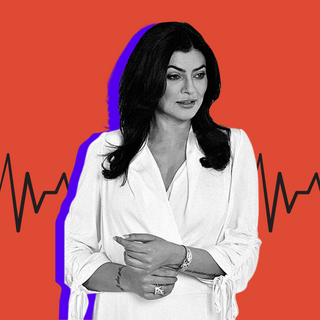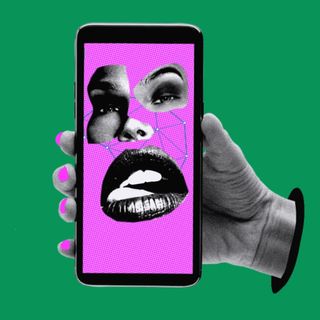
Body Dysmorphic Disorder Is on the Rise; Here’s What You Need to Know About It
The rising popularity of weight-loss fads like Ozempic prompts concerns about body dysmorphic disorder, which experts say is getting worse.

For the average adult user, Ozempic, a new FDA-approved drug, helps those with Type II diabetes manage their blood sugar. Like all drugs, it has several side effects: nausea, dizziness, and weight loss. This last effect has the internet in a frenzy—from TikTok influencers to tech moguls, celebrities have touted Ozempic as the easiest way to lose weight quickly. Ozempic even received a mention at the Academy Awards, when host Jimmy Kimmel made a joke about it. But there is another layer to this fad: there is a deeper anxiety and a looming fear over the drug’s availability and its effect on how we view our bodies over time. The idea of a product which enables weight loss almost like magic is touted as desirable—even at the cost of long-term physical and mental health. But it’s a dangerous slippery slope: not only for those who have an extremely harsh perception of their bodies, but for anybody who is vulnerable to body image issues. With the rise of Ozempic and Ozempic-adjacent drugs, there is a corresponding rise in concerns about body dysmorphic disorder: a condition that’s less researched than eating disorders, but of more relevance in the age of alarming weight-loss fads.
The NHS defines body dysmorphic disorder (BDD) as “a mental health condition where a person spends a lot of time worrying about flaws in their appearance. These flaws are often unnoticeable to others.” The most common symptom of BDD is spending an excessive amount fixated on one’s appearance, but other signs, according to Johns Hopkins Medicine, include constantly checking yourself in the mirror or avoiding mirrors; trying to hide your body parts under clothing; constantly exercising and grooming, and comparing yourself to others; always asking others for validation over looks, but not believing them; and avoiding social activities, especially in the daytime. People with BDD also see an inordinate number of healthcare providers and plastic surgeons, undergo unnecessary cosmetic procedures, and habitually pick at their skin. They are overwhelmed by feelings of anxiety, depression, and shame, and are more likely to be suicidal. BDD is a spectrum disorder, meaning that symptoms can manifest to different degrees for different people—a 44-year-old white man from the American Midwest might not have the same signs as a British-Pakistani young woman, but both share the same feelings of shame, self-loathing, and emotional distress over non-existent or minimal defects. Regardless of whom it impacts, body dysmorphic disorder is getting worse, say experts.
Fundamentally, what distinguishes unhappiness with one’s appearance and body dysmorphic disorder is the extent to which the fixation with your appearance interferes with daily life. Because those with BDD engage in “repetitive compulsive behaviors”, the DSM-V categorizes body dysmorphic disorder as “an obsessive-compulsive related disorder”, indicating an overlap between BDD and OCD. Importantly, eating disorders (EDs) such as anorexia and/or bulimia are distinct from BDD, as people suffering from these are more preoccupied with weight or shape. Few people are aware of BDD’s true dangers, even though it’s more common than EDs; on average, those with BDD experience greater impairment in daily functionality than people with anorexia or bulimia. While BDD is found in all demographics, it is especially prevalent today amongst teenagers and young adults. No one knows the true cause of BDD, although experts can agree that it usually begins in adolescence and affects about 1.7% to 2.4% of the general population; a combination of environmental, psychological, and biological factors can be catalysts. Those with a family history of BDD, abnormal levels of brain chemicals, and adverse life experiences might be at higher risk.
Related on The Swaddle:
Anorexia Is the Most Deadly Eating Disorder; Here’s What You Need To Know About It
The most common treatment for BDD is cognitive behavioral therapy (CBT), although it depends on the severity of the case and the discretion of the healthcare provider. With CBT and other forms of talk therapy, replacing negative thoughts and thought patterns with positive ones are the priority. SSRIs (or serotonin-reuptake inhibitors) have been the medication of choice for patients with BDD, with many noting a substantial improvement in core symptoms, psychosocial functioning, quality of life, and suicidality, among others. Treatment is a long-term commitment, as BDD is chronic and has a significant impact on one’s lifestyle. Unfortunately, recent studies show that because sufferers are worried about “coming across as vain or self-conceited if they disclose that they are preoccupied by thoughts about their appearance,” body dysmorphic disorder is significantly underdiagnosed.
This can have dangerous — even fatal consequences. The effect of social media on BDD under ‘normal’ circumstances is well established but amid the pandemic, adding mirrors and isolation to the mix worsened the symptoms for many, according to Dr Katharine Philips. In her book “The Broken Mirror: Understanding and Treating Body Dysmorphic Disorder”, Philips notes the observable increase in intensified symptoms amongst her patients, and the danger for those at-risk: “the stress of the situation might trigger the onset of full-fledged BDD.” Even before treating it, diagnosing body dysmorphic disorder can be a challenge: because of under-reporting, lack of awareness, and inadequate treatment, many live with a serious medical condition. Thirty-year-old Charlotte Comer died by suicide in 2021 after years of suffering mental battles over the BDD—she “lost hope” over receiving proper help.
In a piece for The Hindu, Colorado State University lecturer Dr Eva Fisher shared how she first began experiencing body dysmorphic symptoms when she was 16. Whether due to her childhood bullying or perfectionism over her appearance, Fisher would spend upwards of eight hours daily obsessing over the shape and size of her nose. Fisher’s fear over others’ judgment expanded to hopelessness about the future—she didn’t want to get married and have children in case they inherited it. At eighteen, Fisher received plastic surgery: while it did make her nose thinner, it did little to alleviate her negative thoughts and preoccupation. “Some patients will have multiple procedures on the same body part; other people are so disappointed by the results … that they want to commit suicide,” she writes.
Few of us are free of self-consciousness or can confidently say that we have no insecurities: the social internet has a large part to play in elevating these worries. Nathan Sing’s BDD diagnosis was a mixed bag, and not one he properly addressed until the pandemic. “Rather than following through with the specialized treatments recommended to me, I convinced myself I was much too busy to go through with them, and that my health and workout routine was sufficient enough to keep me on track and looking my best,” Sing shared with Buzzfeed. Being stuck at home was a catalyst for Sing; hours spent scrolling through photoshopped bodies came with the “resurgence of preoccupations and repetitive behaviors [I] thought [I] grew out of years ago.”
The initial purpose of social media was to communicate seamlessly with people all around the world, but with this heightened version of interaction comes exacerbated social issues like discrimination and shaming. The way we see ourselves is worsened as well; bombarded on all sides with the ‘ideal’ body, career, or relationship, we end up judging our differences harshly. It is no surprise, therefore, that our bodies—the first representation of ourselves to others—are the subject to the most vitriol and modification. Fortunately, with timely intervention, the maladies arising out of this hyper-fixation are treatable — but the phenomenon calls for a closer look at how we navigate our self-perception both online and offline.
Akankshya Bahinipaty writes about the intersection of gender, queerness, and race, especially in the South Asian context. Her background in political science and communication have shaped her past multimedia and broadcasting experience, and also her interest in current events.
Related


Sushmita Sen Is the Latest Celebrity to Get a Heart Attack. Are They Getting More Frequent?
